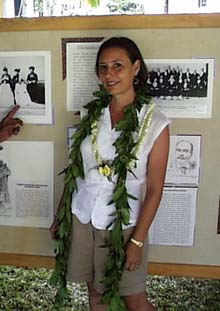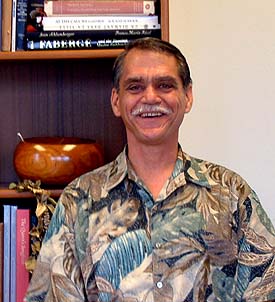 |
 |
 |
|||||||||||||||||||||
|
|
|
|
|
|
|
|
|
||||||||||||||||
|
|
|||||||||||||||||||||||
| Our Guides to Nu‘uanu |
|
|
Aloha! Nu‘uanu is enormously dense with history and important sites bearing on Hawaiian culture and history. For this website, we have consulted with a larger number of people than usual, including community members, organization leaders, and keepers of culture. Here, some of them tell us their stories:
|
||
|
|
||
| Jim Bartels: "I’m Jim Bartels, director of Washington Place. I’m a Hawaiian. I’ve been in the museum business off and on since 1963, and worked for twenty-eight years at ‘Iolani Palace. "In 1998 I was asked to go take over the newly created directorship of Washington Place. Until recently, Washington Place was the oldest residence in Hawai‘i still being lived in. It was built by John Dominis, one of those great, very brave entrepreneurial ship captains. Dominis built a very American style structure -- his wife wanted this to be a sign of American greatness, and she had no real thought that the family would become Hawaiianized in any way. But her son fell in love with a talented princess, Lydia Kamaka‘eha Paki. She would later became Queen Liliu’okalani. "Washington Place is Governor’s mansion today, and the first family felt that it should be shared with the community more, not just being their exclusive house. So their idea was to develop its history and make it available to the public." Jim Bartels passed away before this project was completed.
|
|

|
Lynette Hi‘ilani Cruz: "I am a community-organizer type. But I'm also a mother, and a grandmother, and a Hawaiian woman. I am active in the movement -- the sovereignty movement -- and social justice movements for Hawai‘i. One group is called Sacred Times, Sacred places, and we started about six years ago using the ‘Iolani Palace grounds for gatherings, and later decided to malama the mound, Pohukaina. "Then, as a result of our research on the mound, and on Kamehameha III, we learned of the connection to Kamehameha III's summer house in upper Nu‘uanu, Kaniakapupu, which no one was taking care of."
|
| Kalani: "I was born in Honolulu and raised in Nu‘uanu valley, and have lived in Nu‘uanu valley all my life. I'm also connected with Kona, because my family is from Kona. So I would say I am from both Kona and Nu‘uanu. I guess my home here would be considered upper Nu‘uanu, on what was called Nu‘uanu Avenue when I was little, and before the freeway went in. I grew up there, and played in the area, and my family has lived there -- my mother and her family grew up there, and her aunt was living there. So several generations of us, and as we are native and indigenous people, from probably prior to recorded history."
|
|
|
|
Melvin Lonokaiolohia Kalahiki: "I was born in our home in Kalihi, June 25, 1925. On both sides of my parents, there were deep-rooted cultural values that were instilled in my life. That has made an impact on my entire life. "In Kahalu'u, on my father's side we had kuleana lands in the ahupua'a of Waihe'e. We had four lele from the mountain to the ocean. So we had that experience and responsibility of living off the streams that came out of that valley. Once a month we would clean the main stream from makai to mauka. My father made one big taro patch available for the family's use. So whoever went to get taro for their family, they would clean and plant. The other taro patches were to subsidize my father's income. "My mother's side is from Kohala on the Big Island. I spent several years with my grandfather, living in Kawaihae beneath King Kamehameha's heiau, Pu'ukohola Heiau."
|
| Steven Kubota: "I'm a third generation keiki o ka ‘aina, born in Hawai'i. My ancestors came from Japan. My father grew up on the Big Island in Laupahoehoe, and my mother was born in Kapa‘a, Kaua‘i. "I remember how my ancestors, even coming to Hawai‘i as settlers, were able to survive and harmonize with the land, as a source of food and inspiration. Today all of that is basically gone, so I am working with the Ahupua‘a Action Alliance, on our mission to try to restore that sense of kinship with the land, and the ahupua‘a system.
|
|
 |
Noenoe Silva: "I was born in St. Francis Hospital in Honolulu. My parents, my grandparents, and everybody else lived on the windward side of O‘ahu. I actually grew up in Kailua on O‘ahu and then grew up in California and came back to Hawai‘i as an adult much later on, and studied Hawaiian language. Then one thing led to another and I ended up writing a dissertation in Political Science, about the resistance of native Hawaiians to colonialism of every sort that had happened to them. "I am now an Assistant Professor of Political Science at the University Hawai‘i at Manoa. I also was an Assistant Professor of Hawaiian language there, and I still do teach courses in Hawaiian language at this University as well."
|
Marilyn Kanani Reppun: "I’m the head librarian at the Hawaiian Mission Children’s Society librarian downtown Honolulu. I’ve been here for 13 years as head librarian. I was born in and raised in Honolulu and I am married and have 3 sons. My mother is Hawaiian and my father is Chinese. "I have grandparents from Canton, China and I have grandparents who are Native Hawaiian. My mother also has some Irish in her, so I have a great grandfather born in Belfast, Ireland."
|
|
|
|
|
| In addition to these four guests, we are pleased to hear from William John Kaihe‘ekai Maioho, the hereditary curator of the Royal Mausoleum; Jerry Walker, lua instructor in Nu‘uanu; John Clark, author of several books on Hawai‘i beaches, and from Puakea Nogelmeier, Hawaiian Language instructor at the University of Hawai‘i Manoa, who edited a translation of an important legend relevant to Nu‘uanu. These guides give us first-person insight into aspects of Nu‘unau, past and present. Pacific Worlds welcomes you to explore this historical place through a series of eight thematic topics. Within each of these, you will find short, focused sections exploring particular aspects within that theme. Provided also are bibliographies and links to external sites that will teach you more about the topics discussed.
|
||
|
|
||
| |
| |
|
|

|
| Nu‘uanu Home | Map Library | Site Map | Hawaiian Islands Home | Pacific Worlds Home |
|
|
|||
| Copyright 2003 Pacific Worlds & Associates • Usage Policy • Webmaster |
|||









